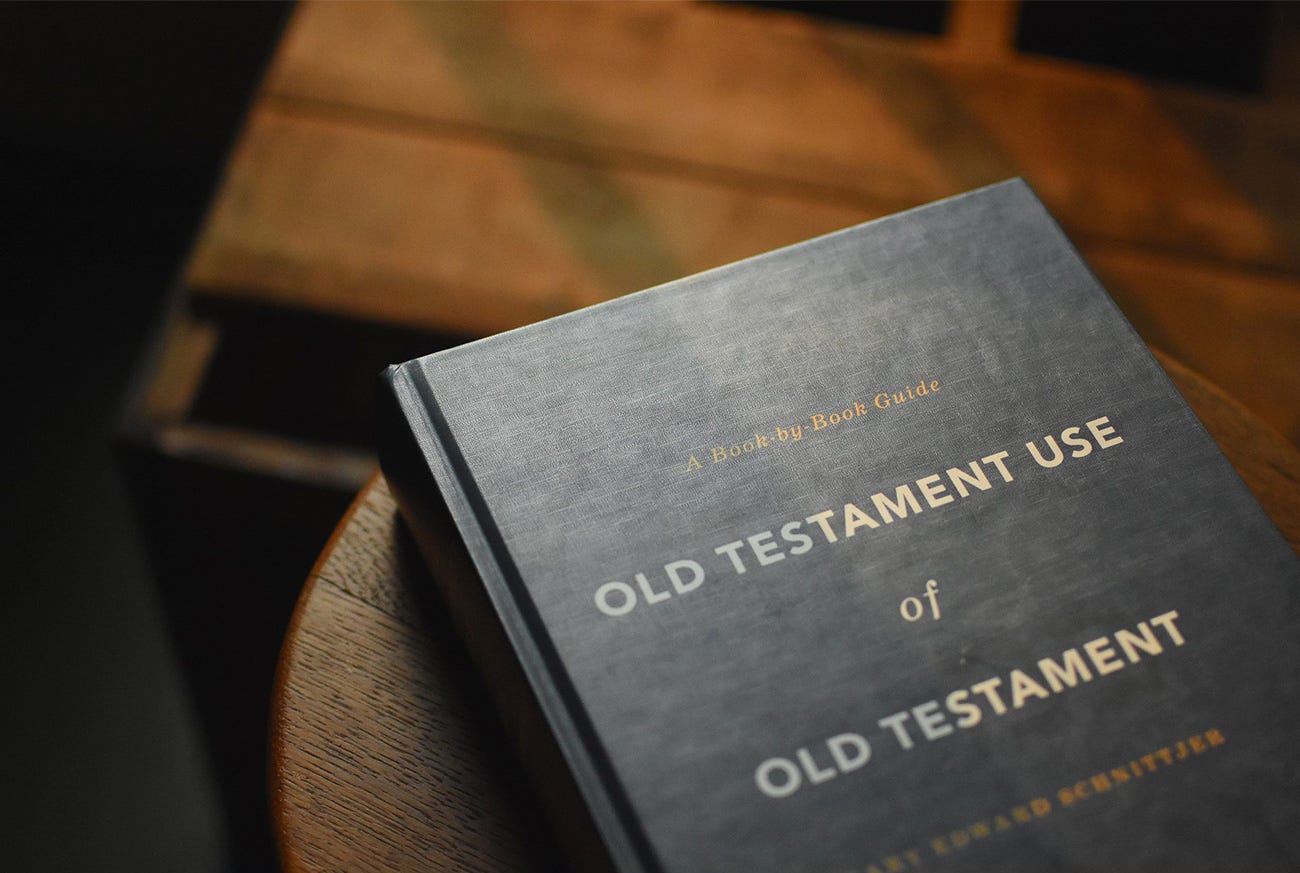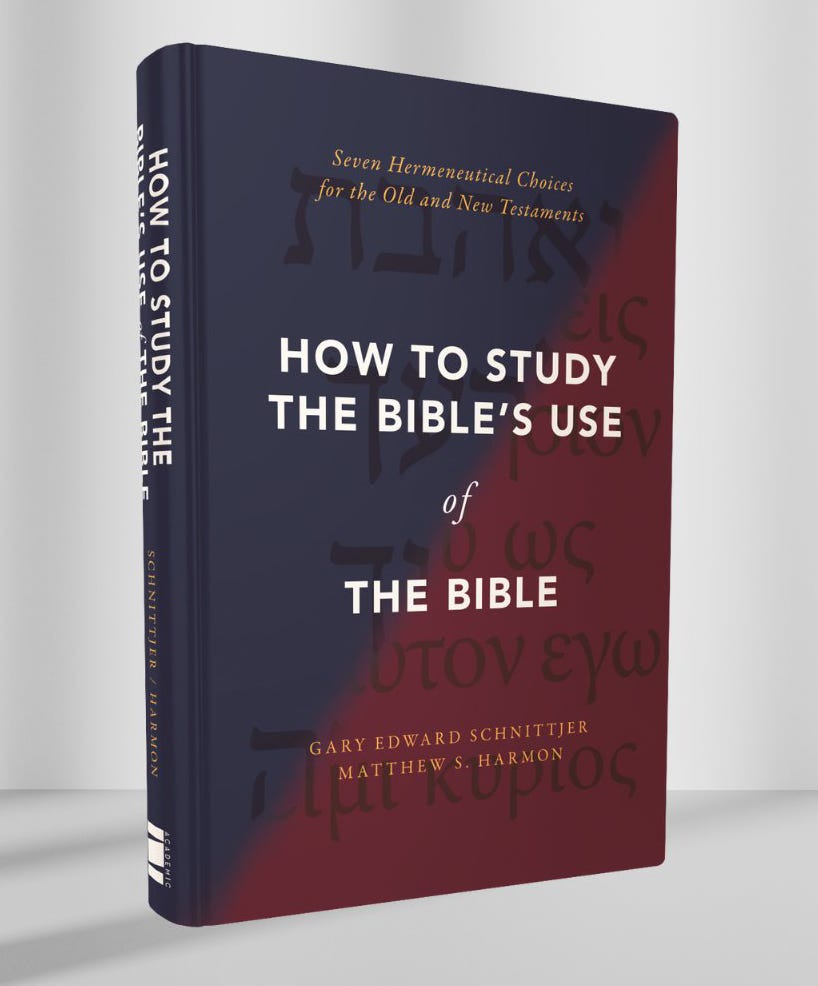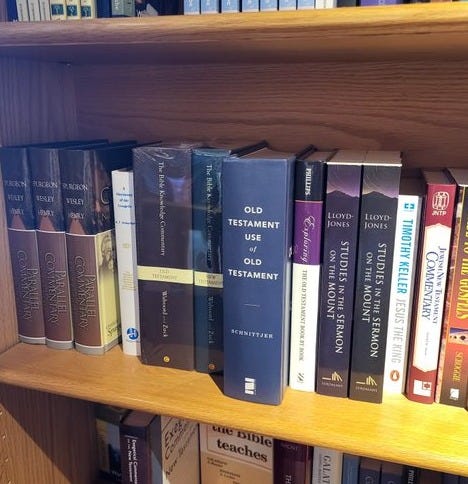Hard Grader of the Bible: Listening to Criticism of OTUOT from Richard Schultz and Greg Beale, part 1 of 2
Old Testament Use of Old Testament
Second-Tuesday Feature
In looking forward to the release of Old Testament Use of Old Testament in Parallel Layout (OTUOTPL) next autumn (in theory, and it’s a good theory), Carpenter’s Student will count down with ten moments about its sister book Old Testament Use of Old Testament (OTUOT).
Number Ten kicks us off in this post with Part 1 of 2: “Listening to Criticism of OTUOT from Richard Schultz and Greg Beale.”
They independently criticized my work in OTUOT in the same way. They said that I am far too hard a grader of the allusions in the Bible. This criticism came out at a panel review of OTUOT sponsored by the Hermeneutics Section of the Evangelical Theological Society (ETS) in Denver. Both Schultz and Beale were effusive in their praise of many other aspects of OTUOT. But this post is dedicated to listening to their independent and shared pushback of me being too hard of a grader of potential allusions.
Accused of being a Hard Grader of Seminary Students
During my seminary and PhD studies I served as TA for a number of professors. The late Dr. Kenneth O. Gangel, my professor of a course on teaching in higher education, hired me to grade papers for him. I liked him a lot, especially for his no-nonsense honesty about the profession of teaching in high ed.
Dr. Gangel was very particular. He divided the papers in half. I graded my half and gave them back to him to return to students. He called me into his office (I thought I was back in grade school). He told me that he had reviewed my grading and that I was right about all of it, but I was severe. I nodded. I told him that I calibrated my grading as a TA based on the standard of the professor I am working for.
Dr. Gangel looked at me for a couple of seconds. He asked, “Are you saying I am a hard man?” I smiled (on the outside while I gulped on the inside) and told him I know he is trying to prepare his students for the realities of academic ministries. He nodded. But he didn’t buy it. And he did not smile back.
The next day, he called me back to his office. Dr. Gangel smiled warmly and thanked me for knowing him as a grader better than he knew himself. I did not know what to say. He told me he had calculated his half and my half of the graded papers and that we were less than one point off overall. He never realized that his grading was so hard until he saw how hard my grading was. Inside I breathed a long sigh of relief.
Dr. Gangel would not be surprised that my seminary students have continued to affirm his view of my grading as being too hard. This has been a source of many spicy “encouragements” from my students in course evaluations over the decades.
But I never expected to be accused of grading the Bible too hard.
Meeting Schultz and Beale in the Lion’s Den
When the ETS Hermeneutics Section invited me to come to a panel review of OTUOT, I blurted out my acceptance. I was thrilled. Then they told me that Richard Schultz and Greg Beale had agreed to critique my book. I was sick. I smiled, and I felt humbled and honored, but I retained that sick feeling constantly for the next twelve months.
Richard Schultz, OT at Wheaton, is a leading scholar of Old Testament use of Old Testament. The research for my OTUOT included working through all of Schultz’s published writings on Old Testament allusions, multiple times. In my view, no scholar was more critical than Schultz of scholars who did shoddy work claiming this, that, and the other Old Testament text alludes to another one without adequate evidence. I fully agree with Schultz. This field of study is overloaded with books, dissertations, and articles that build huge claims of dependence of one biblical writing on another resting on coincidences. Schultz has rightly pushed back again and again emphasizing a need to build interpretation on evidence.
Greg Beale, NT at Reformed in Dallas, is a leading scholar of New Testament use of Old Testament. Beale’s work in this area is characterized by an honesty about difficult biblical allusions. He resists overstating claims. Beale’s scholarly studies routinely remind readers of the loose ends that are a part of determining when one biblical writing alludes to another.
My indebtedness to Schultz and Beale is part of why I was determined not to pad OTUOT with a bunch of unconvincing suggestions of biblical allusions by biblical authors without sufficient evidence. As I managed my anxieties over the months coming up to the panel review of OTUOT, this is an area I did not even consider. I felt like I was of one mind with these two scholars on evaluating potential biblical allusions in the Bible.
I was wrong.
This is their most important criticism.
Grading Allusions
What is an interpretive allusion of an earlier biblical text by a biblical author?
Identifiable donor (cited) text
Identifiable receptor (citing) text
Exegetical outcome of the allusion in the receptor text
If it has one or two of these things but not all three, something might be going on, but it’s not an interpretive allusion. For more detail, see How to . . .
In the field of study of biblical allusions in the Bible, there is a longstanding problem of determining the difference between probable and possible allusions. None of us worry so much about direct quotations—we accept them as allusions. But the vast literature on the Old Testament use of Old Testament is plagued by claims of this text alluding to that one based on little more than the scholar’s imagination plus 200 pages of footnotes of secondary literature.
One of several new elements in OTUOT is grading all potential allusions. Every entry gives a “grade” of the likelihood of the potential allusion based on the classic academic grading system.
A = almost certainly an interpretive allusion
B = probably an interpretive allusion
C = possible interpretive allusion
D = probably not an interpretive allusion
Filters = every chapter filters out passages with similar words and such that are almost certainly not interpretive allusions.
The evidence of potential allusions that needs to be evaluated is verbal (same words or roots), syntactic, and contextual similarities.
There is good reason to think that Jonah exegetically alludes to Yahweh’s attribute formula even though the word order is rearranged.
Yahweh passed before him and proclaimed: “Yahweh, Yahweh a God of compassion and grace, slow to anger and abounding in covenantal loyalty and faithfulness.” (Exod 34:6 author’s translation, emphasis added)
He [Jonah] prayed to Yahweh, “O Yahweh, is not this what I said when I was still in my own country? That is why I fled to Tarshish. For I know that you are a God of grace and compassion, slow to anger and abounding in covenantal loyalty, and who relents from punishment.” (Jonah 4:2 author’s translation, emphasis added)
It is unclear if the psalmist of Psalm 111 alludes to Yahweh’s attribute formula in Exodus 34, or if the psalmist is merely repeating the very commonplace language that appears in many biblical contexts which use this language (see long list in OTUOT, 877; cf. 375‒76). That is, once a few biblical authors allude to the original donor text, a biblical phrase becomes part of the lyrical diffusion (the worship culture of ancient Israel). Does the psalmist allude to Exodus 34 or to the lyrical diffusion of this popular imagery?
He has done great wonders that earn fame, Yahweh is gracious and compassionate. (Ps 111:4 author’s translation, emphasis added)
The purpose of the grading system is to alert readers immediately of the degree of confidence they should place in this or that potential allusion as they research the evidence. This system works well to do away with the long habit of treating all potential allusions in the same way.
Here’s the problem. Someone researches for three years on a potential allusion or set of allusions. The evidence is weak at best, but they write their dissertation anyway (What else should they do with these years of research?) and instead of coming to negative results, they claim that such and so is an interpretive allusion. The state of affairs is very unfair to students just getting started. The student can pick up five different expensive published dissertations and each one acts like they are discovering never-before-considered allusions, but the actual biblical evidence on which the conclusions are based varies widely (for more on this, see Matt Swale’s fantastic new book). The grading system seeks to fix this problem.
So, I do not repent of the grading system. It is essential for scholarship of the Bible’s use of the Bible to make its evaluation of the evidence transparent. It’s wrong for us to wink and make students waste time just because we traced out a rabbit trail to a dead end and don’t know what to do with our research.
But what if I graded potential allusions too hard?
Hard Grader
Schultz agrees with the value of the grading system for evaluating potential biblical allusions. But he pushes back against my use of it. He said in his critique of OTUOT:
Schnittjer helpfully employs a rating system . . . Having reviewed nearly every example he discusses related to the book of Isaiah, I would conclude that this reference work does not suffer from “grade inflation”! . . . In the process of “screening out false positives,” Schnittjer employs a variety of “filters” . . . Accordingly, in his treatment of each OT book, he lists the filters employed and the “Level F” verbal parallels “filtered out” by them. (He gives lots and lots of “F’s”!) This is another unique feature of this reference work, and I greatly appreciate the “transparency” (OTUOT, xxii) of his procedure. In short, he devotes considerable space in the book to explaining why specific verbal parallels do not qualify as “interpretation” . . . even if other scholars think they do, and it is helpful that he nevertheless lists them in each chapter rather than simply omitting them. (Richard Schulz, “Exegesis in the Hebrew Bible as Progressive Revelation: Methodological Reflections,” unpublished invited conferences paper, Hermeneutics Section, ETS, 16 Nov 2022, emphasis added.)
In a section of his critique entitled “Schnittjer’s Minimalistic Approach to Allusions,” Beale’s written remarks make reference to the “Filters” section of each chapter. But he went off script and referred to me throwing non-allusions into the trash. This got a big laugh from me and everyone there. In my response, it also led me to explain to those attending that all non-allusive scripture is just as important as allusions to scripture in scripture. This is something I had stated in the introduction of OTUOT (xxiii).
Beale contrasts the dissertation of Derek Bass on Hosea’s use of earlier scripture to my chapter on Hosea in OTUOT. He pointed out that Bass found seventy-five places where Hosea alludes to earlier scripture but I only found four. Beale notes that I had read Bass’s dissertation, stating where OTUOT footnotes it. Beale pushed back against such meager results in the chapter on Hosea in contrast to so many in Bass’s research. (Greg Beale, “The Use of the Old in the Old as a Pattern for the Use of the Old in the New,” unpublished invited conferences paper, Hermeneutics Section, ETS, 16 Nov 2022.)
When Beale served as a reader for Bass’s dissertation, he had his TA put together a three-page table listing all of Bass’s proposed allusions. And he looked them up. I respect this kind of interaction with a doctoral student’s work.
In my response to Beale’s critique, I pointed out that Bass and I define “interpretive allusions” differently which accounts for many of the cases that Bass sees allusions that I do not. My definition is above—all interpretive allusions must have: identifiable donor text, identifiable receptor text, and identifiable interpretive outcome in the receptor text. Meanwhile, when explaining what he means by a “definite allusion,” Bass says:
“An allusion can also be present even if the precise source text is impossible to pinpoint” (Derek Drummond Bass, “Hosea’s Use of Scripture: An Analysis of His Hermeneutics,” PhD dissertation, The Southern Baptist Theological Seminary, Louisville, 2008, 100).
I can agree to a broad allusion with an uncertain donor text, but not an interpretive allusion. I pointed out in the live session that Bass’s assertion that allusions can be present when they lack evidence of a specific donor text does not align with Greg Beale’s view of allusions. Beale says that allusions include “the notion of a conscious intentional authorial reference to an OT text” (Greg Beale, “The Old Testament in Colossians: A Response to Paul Foster,” Journal for the Study of the New Testament 41.2 [2018]: 267 [261‒74]). I heartily agree with Beale here.
Greg Beale also pushed me on whether “holy seed” in Ezra 9:2 alludes to Isaiah 6:13. This is an important example of a disagreement that I will come back to in part 2.
Revisiting Hosea
I have gone back to Hosea and added a few entries of potential allusions for OTUOTPL. Not seventy-five. But a few. Here’s my favorite new one.
And God said to Moses, “I am [אֶהְיֶה] that I am.” And he said, “So you must say to the Israelites, ‘I am [אֶהְיֶה] sent me to you.’” (Exod 3:14 LEB, emphasis added)
Then Yahweh said, “Call him Not-Mine, for you are not my people, and I am not your I am [אֶהְיֶה]. (Hos 1:9 author’s translation, emphasis added)
OTUOTPL will introduce this entry something like this:
Hosea 1:9 includes a negation of a standard covenant formula with a twist. An example of the standard full covenant formula appears in Jer 11:4b—“and you will be my people, and I will be your God” (NIV) (וִהְיִיתֶם לִי לְעָם וְאָנֹכִי אֶהְיֶה לָכֶם לֵאלֹהִים). In Hos 1:9, instead of ending with the expected “your God,” the covenant formula uses “I am” (אֶהְיֶה) in a way that evokes the revelation at the burning bush.
There are more surprises in OTUOTPL that need to wait for now: color-coding, parallel Hebrew and English, and more.
Curving the Grades?
I don’t curve the grades of my seminary students. Ask them if they appreciate this policy of mine.
I have heard the independent and shared criticism of my hard grading on potential allusions in OTUOT. Schultz and Beale are right about this.
What does repentance look like in this case? It includes a reevaluation of lots of borderline cases throughout the Old Testament that did not make the cut in OTUOT. Several dozen new entries on interpretive allusions will appear in OTUOTPL. I will preview a couple of these in Carpenter’s Student over the next months in the run up to its release. Repentance also means that I plan to re-grade every entry in OTUOT for the second edition. I expect many C’s (possible) to get upgraded to B’s (probable).
I still plan to be a careful grader of potential allusions. But Schultz and Beale rightly called me out for being too hard of a grader.
I am grateful for the lively and thoughtful feedback on OTUOT by Richard Schultz and Greg Beale. I respect both of them as scholars of the Bible’s use of the Bible. I am indebted to them for helping me.
Want More?
The countdown of ten moments of OTUOT to prepare for the release of OTUOTPL will go all the way back to the beginning . . . That’s right! Origin story.
The countdown will highlight articles, podcast interviews, and research discoveries from the archives not yet put up on Carpenter’s Student.
For now, please see many items appearing on the OTUOT+ tab of Carpenter’s Student.
Check out what a church bookstore with taste looks like:
Coming Up
“Why Waste Time with the Old Testament?” is the question I plan to tackle in the next Second-Tuesday Feature of Carpenter’s Student.
Also look for announcements of soon-to-be-released publications and podcast interviews.
If you missed the great time we had in the live reading club session with Dr. Bryan Murawski a couple of weeks back, please watch for the next live reading club session.
Cairn University
This morning I enjoyed a Psalm 42:1 moment when I walked onto campus from the train.
Walk a different path with us. Prioritize Christ and his word.








Thanks for this! I wasn't in that session, and it's interesting to hear how OTUOT was received.
Gary, thank you for humility, willingness to listen, and openness to change. It is a quality that I have appreciated since you first took the time from your doctoral studies to explain difficult theological concepts to a budding ThM student way back in the 90's. I was privileged to be in the room during your interactions with Drs Beale and Schultz and was again struck by the comity (leavened with no little comedy) of the conversation, underpinned by the evident respect you had for both men and the respect they had for your work. To my mind, the meeting was the epitome of how an academic conference should be conducted. The results, manifested in your upcoming edition, testify to that judgment. I pray for the success of the upcoming work and continue to look to you as a model of Christian scholarship.